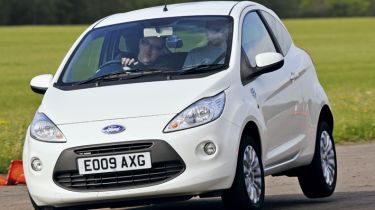Ford Ka 1.2 Zetec
City Car
With less weight to slow down, city cars should stop well – but that’s not always the case.
The braking systems on these traditionally low-priced models are often less advanced – and easier to produce, to keep costs down. Plus, their narrow tyres ensure they rarely stop as quickly as more expensive and better-equipped vehicles. Will this be true for Ford’s new Ka?
On its road test debut (Issue 1,047), the blue oval baby fared well in our traditional straight-line braking assessment. But in this company, it faces a tough challenge – especially as it’s the only car here with old-fashioned drum brakes at the rear.
That’s not to say the Ka is completely bereft of technology. Its ABS includes brake assist and the hazard warning lights flash automatically during hard braking. Crucially, though, the anchors provide decent bite in the normal emergency stop.
This meant there was no drama in the Ford’s 70-0mph straight-line test. Thanks to the soft suspension, the nose squats forwards, leaving the suspension unloaded at the rear. But while that’s relatively harmless in this test, where the front wheels do most of the work, stability is a big issue when you introduce the lane change element.
In our extreme direction change, the Ka suffers lots of body roll, and the combination of its relatively skinny tyres and unloaded rear suspension causes the rear of the car to lose grip. As stability control isn’t fitted (it’s a £300 option), you need to correct the steering quickly to bring it back under control. This has to be well timed and accurate, too, to prevent the weight transfer from causing pendulum-style slides as you try to control its momentum.
Bearing in mind the Ka’s traditional popularity among first-time drivers, this is a frightening scenario. And it really highlights the benefits of stability control – we suggest buyers think carefully before splashing out on cosmetic add-ons ahead of this option.
The small contact patch of those tyres, plus the relative lack of body control, means the Ford took the longest to stop in both tests. And without the benefit of the stability system, it was the only car that couldn’t complete the lane change to return to its original line and stop between the gates. What’s more, the seats are the least supportive in this test.
All too easily, we found ourselves sliding out of the driver’s chair during our emergency manoeuvre. Then again, we have to put the Ka’s performance in perspective – because it still stops far more impressively than city cars of old.







